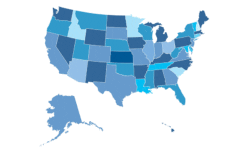Top Five Reasons Colleges and Universities are Moving to Smart Cards
Did you know that that 95% of universities and colleges still rely on legacy technology such as magnetic stripes or simple proximity cards for access control?

Did you know that that 95% of universities and colleges still rely on legacy technology such as magnetic stripes or simple proximity cards for access control? Unfortunately, this dated technology leaves these institutions open to security vulnerabilities that often result in increased duplication and fraudulent card use.
However, as university populations have grown and technology advancements have been made, many institutions are now seeking more secure, economical, and streamlined solutions to meet the needs of their student body and staff — not only for safeguarding people, assets and data – but for connecting students to a myriad of services and applications campus-wide — from physical facility and logical network access to cashless payment and tracking time and attendance.
In order to provide a more secure, convenient and flexible on-campus credential experience to their students, faculty, and staff, forward-thinking universities are now moving away from traditional magnetic stripe (magstripe) and low-frequency proximity card technologies in favor of high-frequency, contactless “one-card” technology for their student ID programs.
There are five key reasons these institutions are moving to smart cards:
1. Increased Security and Safety
Upgrading to contactless smart card technology bolsters physical access to buildings while strengthening logical access to networks, computers, documents, data, student health and financial records. Additionally, smart card embedded technologies inherently thwart fraudulent card use and card cloning, not only ensuring secure building access, but protection for other card uses such as debit purchases or banking transactions. Migrating to a “smart,” secure credential can also eliminate the need for physical keys — which can all-too-easily be copied and are notoriously vulnerable to loss or theft.
2. Cardholder Convenience
Photo ID, residence hall key card, library card, cafeteria pass, bus pass – how many cards do today’s university students juggle? With contactless smart cards, institutions can combine of all of those functions onto a single, highly secure campus “one card” and not only streamline their operations but greatly enhance the campus credential experience for students and staff alike.
3. Greater Flexibility
Beyond on-campus convenience, multi-application smart cards allow for secure interoperability with off-campus applications such as transit and banking. What’s more, with the added flexibility that smart card technology affords, new applications or updates to existing applications such as library privileges or dining plans – can be added or modified at any time without having to issue new cards.
4. Long-term Efficiency Gains and Cost Savings
Multi-function smart cards provide improved security operations, more efficient workflows and easier management of ID programs for students, faculty, and staff. Due to better risk management with the increased security of smart cards, universities may also experience reduced insurance premiums.
5. Path to the Future
Migrating to a unified, underlying smart card technology platform for all application needs affords institutions the ability to transition at their own pace as budget and resources allow — laying a solid foundation for adding new technologies and capabilities as they become available or increasingly more affordable.
Read HID Global’s Executive Brief to learn more about each of these 5 key reasons why colleges and universities are moving to multi-function smart cards. Click here to view the ‘Top 5’ infographic.
If you appreciated this article and want to receive more valuable industry content like this, click here to sign up for our FREE digital newsletters!
 Leading in Turbulent Times: Effective Campus Public Safety Leadership for the 21st Century
Leading in Turbulent Times: Effective Campus Public Safety Leadership for the 21st Century
This new webcast will discuss how campus public safety leaders can effectively incorporate Clery Act, Title IX, customer service, “helicopter” parents, emergency notification, town-gown relationships, brand management, Greek Life, student recruitment, faculty, and more into their roles and develop the necessary skills to successfully lead their departments. Register today to attend this free webcast!








